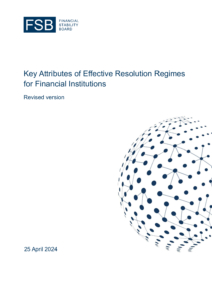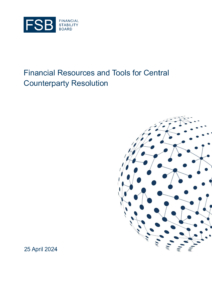This guidance was originally published on 16 November 2020. This revised version incorporates the FSB’s toolbox approach to financial resources and tools to support the resolution of systemically important central counterparties.
This report sets out guidance to support authorities in their assessment of the adequacy of financial resources for central counterparty (CCP) resolution and of the treatment of CCP equity in the context of resolution. This now includes assessing whether the resolution authority has access to a set of resolution-specific resources and tools consistent with the additions made to the Key Attributes Annex on the resolution of financial market infrastructures (FMIs) and FMI Participants (Appendix II-Annex 1, paragraphs 4.19-4.23). Resolution authorities should conduct such assessment in cooperation with the CCP’s oversight and/or supervisory authorities. For CCPs that are systemically important in more than one jurisdiction, such assessment should be reviewed and updated on an annual basis and the results of such review/update be discussed within the firms’ crisis management groups.
Part I of the guidance proposes five steps to guide the authorities in assessing the adequacy of a CCP’s financial resources and the potential financial stability implications of their use. The authorities should:
-
Step 1: identify hypothetical default and non-default loss scenarios (and a combination of them) that may lead to a resolution of a CCP;
-
Step 2: conduct a qualitative and quantitative evaluation of existing resources and tools available in the resolution of the CCP;
-
Step 3: assess potential resolution costs;
-
Step 4: compare existing resources and tools to resolution costs and identify any gaps; and
-
Step 5: evaluate the availability, costs and benefits of potential means of addressing any identified gaps.
Part II of the guidance addresses the treatment of CCP equity in resolution. It provides a framework for resolution authorities to evaluate the exposure of CCP equity to losses in recovery, liquidation and resolution and how (where it is possible) the treatment of CCP equity in resolution could be adjusted.

